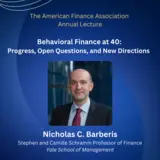
[Webinar Recap] YBlockchain? Episode 002: Blockchain as a Building Block For The Data Economy, Fueled by Transparency & Trust
The Yale ICF partnered with Yale SOM alumna, Diana Barrero Zalles ’17, to create a series of discussions about blockchain presented through a variety of panels and keynote addresses by leading practitioners and academics in the field. In this webinar recap, Diana expands upon her conversation with Cristina Dolan, Founder and CEO of InsideChains, about the data economy, blockchain innovations and privacy in a connected world.
interviewed Cristina Dolan, Founder & CEO
of InsideChains, about the data economy,
blockchain innovations and privacy.
It’s been an incredible privilege to interview Cristina Dolan, Founder and CEO of InsideChains, and tech pioneer since the early days of the Internet. She shared her insights on the data economy and how blockchain innovations form part of the imminent Fourth Industrial Revolution in combination with other innovations like Artificial Intelligence and Machine Learning. Journeys of data, where relevant information is openly available but individual privacy is secured because the data is anonymous, are becoming increasingly valuable across industries.
To begin, there was a huge amount of excitement around blockchain during the years of the ICO hype. While that was a time of hyperinnovation and many interesting solutions were indeed developed, what most people forgot was that these are networked technologies that depend on ecosystems of users. The value wasn’t quite created in those networks. In many ways it’s not just about the technology, but likely even more so about the network, which requires communities to engage with these innovations at the application level. Metcalfe’s Law states that the value of an innovation increases with the level of user engagement (e.g. the telephone). Many of these new technologies have been missing the network effect, which is a requirement for any of these technologies to take off. This can provide lessons for today’s DeFi excitement, where we are also seeing a lot of experimentation and new business models that need community engagement to succeed.
As the following Union Square Ventures image on protocols shows, value creation in the world of the blockchain is different from what occurred in the world of the Internet, where shared protocols like TCP/IP, HTTP produced much less attention and returns than the applications built on top of them, like Facebook and Google. It is the applications that have created and captured by far most of the value. On the contrary, in the blockchain world, most of the value remains at the level of shared protocols, like the Bitcoin and Ethereum networks, and much less is created by the distributed applications layer on top of them. Most ICOs were built on the Ethereum blockchain to make use of smart contract capabilities.
This phenomenon is based on the premise that better products and services can be created when built on open and decentralized stores of user data, where data is not limited to specific organizations or entities and thus there are no data silos. The resulting ecosystems of products and services are also more interoperable among each other because they are built on the same open protocols. The availability of shared open data, along with an incentive system that no longer allows “winner-take-all” markets, has enabled a new class of companies with different business models.
The immense availability of open data creates unprecedented opportunities for businesses to gather insights and make strategic decisions. Blockchain, for instance, can be used to immutably record the massive amounts of data gathered by IoT connected devices, making it openly available. AI can then step in to enhance insights based on that data. The EU Blockchain Observatory discusses this convergence. In a sense the network is not just about the individuals as users, but also about the devices recording data in conjunction. The advantage that the blockchain provides is in its transparency, recording complete journeys of data that would otherwise often be siloed across different institutions. There are a host of different areas that can make use of openly available journeys of data.
Regulators, for instance, can take advantage of this transparency to better comply with the EU’s 5th anti-money laundering Directive (AMLD5) and its upcoming 6th iteration. With increasingly stringent regulatory requirements with respect to AML and KYC, transparency of data may become more of a requirement in order to remain compliant. Cryptocurrency exchanges, for instance, can look up the journeys of data on the transactions to find the trajectory of hacked funds and identify the exact wallets where they are held. Hackers, in turn, may no longer be able to access their stolen funds because as soon as they try to move them across wallets or convert them to fiat currency, they’d be under surveillance and may get caught. Regulatory technology companies have made use of this open data to create solutions to identify and trace funds linked to illicit activity. Blockchain provides transparency at a time when regulators are demanding more trust.
In financial services, journeys of data can capture the entirety of information throughout the process to make a decision on a trade. Clearing and settlement have historically been and continue to show several inefficiencies, with t+2 or even several days during a trade when the ownership of a financial product is unclear. The financial crisis can only bring light to these inefficiencies. Moreover, ownership of any share is represented today by an IOU from financial institutions, with little clarity on who owns exactly what shares. The whole business model behind Broadridge, a multi-billion dollar company, is to simply bring clarity on who owns what so shareholders can vote accordingly. Blockchain can greatly facilitate greater clarity on ownership in a real-time basis. The DTCC is also exploring a range of use cases to streamline trade processes and reduce counterparty risk through transparency.
[WATCH] YBlockchain? Episode 002: Blockchain as a Building Block For The Data Economy, Fueled by Transparency & Trust
Moreover, the EU’s Payment Services Directive (PSD), in its latest iteration as PSD2, forms the premise behind open banking. Financial services data from large institutions was made openly available via APIs and allowed fintech startups to develop tailored solutions, which particularly benefitted financially underserved communities. Blockchain ledgers can further facilitate the use of data from one system across other systems and entities, to provide better services that traverse across networks rather than remaining within siloed systems. This is particularly valuable given that the vast majority of companies worldwide are small and medium enterprises, that companies are remaining private for longer as seen by the decline in yearly IPOs, and that access to funding has been lacking for these small companies.
The rise of the shared economy can represent a huge use case to benefit from open data systems. Financial services can now be embedded into customer journeys (e.g. Uber integrating payments integrated into the service itself), such that traditionally non-financial companies can come to provide financial services as part of their other products. The company captures the customer at no additional cost, the service provider gets paid in the moment, and the underlying financial services provider can settle quickly as well. Much of today’s digital transformation across industries will rely on such open data sharing, especially as the S&P 500 has experienced a dramatic increase in intangible assets.
Other applications in supply chain can focus on the provenance of food, or the sustainably sourced supply of jewelry such as diamonds. In trade finance, information has to be exchanged across multiple organizations in multiple jurisdictions, and an open data repository like blockchain can facilitate automated information sharing. Shipping containers, for instance, could feed in data into the network upon arrival into a port. Blockchain can connect otherwise separate supply chains from the origin of a product, its transportation across physical distances, and the inventory management system where it is sold.
In the healthcare space, data journeys can be invaluable for understanding the provenance of pharmaceuticals, such as ensuring adequate temperature and conditions of cold supply chains for the much awaited COVID-19 vaccines. There is also a privacy feature where these journeys reveal the relevant data but don’t reveal the specific individuals from whom it originates. Today healthcare data can be arguably even more valuable than financial data, since prescriptions for painkillers for legitimate patients can be stolen and used in illicit markets. Journeys of openly available data would allow detection of such activity, just like illicit financing activity and hacks as mentioned above. Moreover, the new trend of value-based medicine, which focuses on patient outcomes, can make use of patient journeys of data to make better decisions on patient care, incentivize them to form healthier habits, and ensure their privacy. Cristina co-founded the company Additum, which utilizes patient journeys of data to improve preventive, predictive, and personalized healthcare.
With this new class of business models built upon open data, the infrastructure to store it securely, make it widely available, and ensure the adequate level of privacy for individuals is paramount. There have been different versions of distributed ledgers that have iterated upon the Bitcoin blockchain, allowing a new level of peer-to-peer interactions that can bring value in a range of different ways. When integrated with other emerging innovations, blockchain can facilitate the provision of these new infrastructures, such that data can be capitalized upon in innovative and secure ways that can greatly impact our lifestyles.
Visit the ICF Events webpage to find out more about upcoming YBlockchain? webinars.
 About Diana Barrero Zalles ‘17: Diana Barrero Zalles advises on blockchain innovation, crypto fund investments, and regulation. She has identified best practices and developments from around the world and compiled recommendations for effective blockchain legislation and business models. She also contributes to Global Digital Finance working groups to standardize best practices. She published market research on stablecoins and is working to advance tools in the space in light of decentralized finance developments. Previously, she managed large cross-border transactions with the investment banking offices of the World Bank and Inter-American Development Bank in Washington DC. She went to the University of Notre Dame and has an MBA from Yale.
About Diana Barrero Zalles ‘17: Diana Barrero Zalles advises on blockchain innovation, crypto fund investments, and regulation. She has identified best practices and developments from around the world and compiled recommendations for effective blockchain legislation and business models. She also contributes to Global Digital Finance working groups to standardize best practices. She published market research on stablecoins and is working to advance tools in the space in light of decentralized finance developments. Previously, she managed large cross-border transactions with the investment banking offices of the World Bank and Inter-American Development Bank in Washington DC. She went to the University of Notre Dame and has an MBA from Yale.
Related:
-
Announcing the Yale ICF's Fall YBlockchain? Webinar Series
-
November 19, 2020: YBlockchain? Episode 003: Blockchain & Connected Devices: Resilient Networks and COVID-19 Contact Tracing As a Business Use Case
-
Speaker: Garrett Kinsman, Co-Founder, Nodle Network
-
-
October 28, 2020: YBlockchain? Episode 002: Blockchain as a Building block for the data community, Fueled by Transparenct & trust
-
Speaker: Cristina Dolan, Founder & CEO, InsideChains
-
-
September 8, 2020: YBlockchain? Episode 001: Blockchain and Illicit Activity: Demystifying Assumptions and Lessons Learned for Financial Innovation
-
Speaker: Gregory Lisa, Partner, Hogan Lovells US LLP.
-
-
October 1, 2019: YBlockchain? for Business and Society
-
Speakers: Jeff Bandman, CEO, BlockAgent; John D’Agostino, Managing Director, DMS Governance; Kelly LeValley Hunt, Blockchain Advisor & Venture Partner, XLP Capital; Ken Lang, Managing Partner & CTO, COSIMO Ventures; Sandra Ro, CEO, Global Blockchain Business Council; Frances Newton Stacy, Director of Portfolio Strategy, Optimal Capital; David Weild IV, Chairman & CEO, Weild & Co.
-
Conference Recap: YBlockchain? For Business and Society
-



